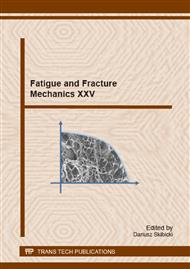[1]
M.N. Aboushelib, J.P. Matinlinna, Z.S. Salameh, H. Ounsi Innoveations in bonding to zirconia – based materials: Part 1, Dental materials, 24, p.1268 – 1272.
DOI: 10.1016/j.dental.2008.02.010
Google Scholar
[2]
M. Guazzato, K. Pross, L. Quach, M. Swain, Strenght, reliability and mode of fracture of bilayered porcelain/zirconia (Y-TZP) dental ceramics, Biomaterials, 25, pp.5045-5052.
DOI: 10.1016/j.biomaterials.2004.02.036
Google Scholar
[3]
K. Castkova, G. Hadraba, J. Cihlar, Hydrothermal ageing of tetragonal zirconia ceramics, Ceramics – Silikaty, 48, 3, pp.85-92.
Google Scholar
[4]
A. Rudawska, Ł. Dunia, Wytrzymałość statyczna I długotrwała połączeń klejowych blach ocynkowanych, Technologia I automatyzacja montażu, 3, pp.31-34.
Google Scholar
[5]
J. Domińczuk, Wpływ wybranych czynników konstrukcyjnych i technologicznych na wytrzymałość połączeń klejowych, Postępy nauki i techniki, 10, pp.14-26.
Google Scholar
[6]
M. Hatta, A. Shinya, D. Yokoyama, H. Gomi, P. Vallittu, A. Shinya, The effect of surface treatment on bond strength of layering porcelain and hybrid composite bonded to zirconium dioxide ceramics, J of Prosthodontic Reaserchm 55, pp.146-153.
DOI: 10.1016/j.jpor.2010.10.005
Google Scholar
[7]
K. Seto, E. McLaren, A. Caputo, S. White, Fatigue Behavior of the resinous cement to zirconia bond, J of Prosthodontic, 00, pp.1-6.
DOI: 10.1111/jopr.12053
Google Scholar
[8]
Hagge MS, Lindemuth JS, Shear bond strength of an autopolymerizing core buildup composite bonded to dentin with 9 dentin adhesive systems, J of prosthetic dentistry, 86, pp.620-623.
DOI: 10.1067/mpr.2001.119683
Google Scholar
[9]
EJ Swift Jr, Ask the experts: self-cured composites, J Esthet Dent, 11, p.120.
Google Scholar
[10]
N Nakabayashi, Bonding of restorative materials to dentine: the present status in Japan, nt Dent J, 35, pp.145-154.
Google Scholar
[11]
Weibull, W. (1951), A statistical distribution function of wide applicability, J. Appl. Mech. -Trans. ASME 18 (3): 293–297.
DOI: 10.1115/1.4010469
Google Scholar
[12]
Palin W.M., Fleming G.J.P., Burke F.J.T., Marquis P.M. Randall R.C. The reliability in flexural strength testing novel dental composite J of Dent. 2003: 31 pp.549-557.
DOI: 10.1016/s0300-5712(03)00110-6
Google Scholar
[13]
Wirwicki M., Topoliński T., Analysis of P-M Damage Accumulation in Zirconium Dioxide; Testing through Gradually Increasing Load Method, Key Engineering Materials, Vol. 598, p.255 – 260.
DOI: 10.4028/www.scientific.net/kem.598.255
Google Scholar
[14]
Wirwicki M., Topoliński T., Determining the S-N Fatigue Curve for Lava Zirconium Dioxide, Advanced Materials Reserch Vol. 845 p.153 – 157.
DOI: 10.4028/www.scientific.net/amr.845.153
Google Scholar


